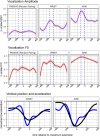Gesture-speech physics in fluent speech and rhythmic upper limb movements
- PMID: 33336809
- PMCID: PMC8246948
- DOI: 10.1111/nyas.14532
Gesture-speech physics in fluent speech and rhythmic upper limb movements
Abstract
It is commonly understood that hand gesture and speech coordination in humans is culturally and cognitively acquired, rather than having a biological basis. Recently, however, the biomechanical physical coupling of arm movements to speech vocalization has been studied in steady-state vocalization and monosyllabic utterances, where forces produced during gesturing are transferred onto the tensioned body, leading to changes in respiratory-related activity and thereby affecting vocalization F0 and intensity. In the current experiment (n = 37), we extend this previous line of work to show that gesture-speech physics also impacts fluent speech. Compared with nonmovement, participants who are producing fluent self-formulated speech while rhythmically moving their limbs demonstrate heightened F0 and amplitude envelope, and such effects are more pronounced for higher-impulse arm versus lower-impulse wrist movement. We replicate that acoustic peaks arise especially during moments of peak impulse (i.e., the beat) of the movement, namely around deceleration phases of the movement. Finally, higher deceleration rates of higher-mass arm movements were related to higher peaks in acoustics. These results confirm a role for physical impulses of gesture affecting the speech system. We discuss the implications of gesture-speech physics for understanding of the emergence of communicative gesture, both ontogenetically and phylogenetically.
Keywords: biomechanics; entrainment; hand gesture; speech acoustics; speech production.
© 2020 The Authors. Annals of the New York Academy of Sciences published by Wiley Periodicals LLC on behalf of New York Academy of Sciences.
Conflict of interest statement
The authors declare no competing interests.
Figures







References
-
- Feyereisen, P. 2017. The Cognitive Psychology of Speech‐Related Gesture. New York: Routledge.
-
- Holler, J. & Levinson S.C.. 2019. Multimodal language processing in human communication. Trends Cogn. Sci. 23: 639–652. - PubMed
-
- Streeck, J. 2008. Depicting by gesture. Gesture 8: 285–301.
-
- Shattuck‐Hufnagel, S. & Prieto P.. 2019. Dimensionalizing co‐speech gestures. In Proceedings of the International Congress of Phonetic Sciences , Melbourne, Australia.
-
- Wagner, P. , Malisz Z. & Kopp S.. 2014. Gesture and speech in interaction: an overview. Speech Commun. 57: 209–232.
Publication types
MeSH terms
LinkOut - more resources
Full Text Sources

